Family : Laridae

Text © Dr. Gianfranco Colombo

English translation by Mario Beltramini
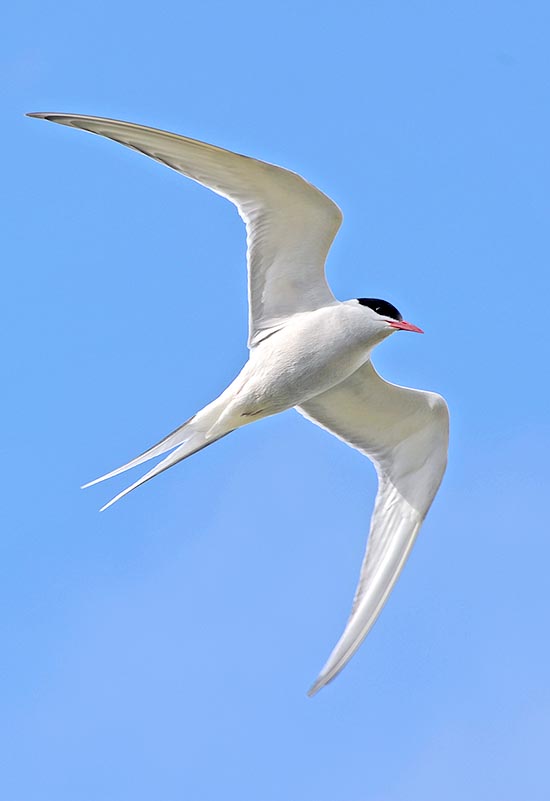
The Sterna paradisaea migrates from one pole to the other covering 90.000 km per year © Gianfranco Colombo
As a matter of fact, some time before that date, he collected imaginative statements and naturalistic adventures that he reported in a book that was telling of sea monsters of which, in an illuminist phase of the western world, they questioned the real existence.
He described the hideous sea serpent that caused enormous waves, the kraken, the giant cephalopod that dragged the vessels to the bottom of the sea, the mermen and the mermaids, beings half humans and half fishes and told this with such conviction that for decades more and until the mid-twentieth century people believed in their existence.
The Arctic tern or Longtail tern (Sterna paradisaea Pontoppidan, 1763) by sure had nothing of imaginative at that time but centuries later, with the means made available by the modern technology, they understood that Mr. Pontoppidan had unconsciously classified a bird whose air capabilities would have left a mark in the naturalistic history, rightly like its imaginative animals.
This seabird belongs to the order of the Charadriiformes and to the family of the Laridae and it is mainly characterized by its frequenting particularly cold areas.
It is easy to talk about migration in a world where the beings involved are called birds and almost all of them have wings fit for flight.
There is who migrates on the north-south route escaping, when in the bad season, temperatures that become unbearable, there is who going down from the top to the bottom from very high mountains in valleys, who crosses oceans to reach islands where to nidify and who, within vast continents, moves in all directions following the rain season. Among these migrants some will fly for short distances, others for very long ones but never any other bird will be able to add up the unbelievable distances that this small tern will cover during its life.
After about one month from the birth, occurred in some little beach of the Arctic tundra, this bird starts flying and will stop only after one year when will retrace its steps looking for a place where to nidify. Some of them will do this in later years loafing even more over seas and oceans. It will fly incessantly to the south up to Antarctica on the edge of the Polar pack edge and on the nearby seas but following whimsical routes that will take it to every corner of the world, covering annual distances even of 90.000 km.
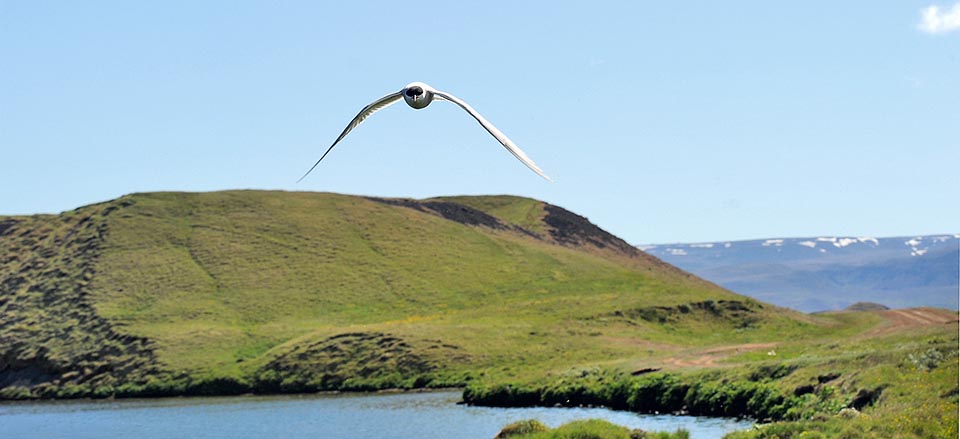
Here it is, to nidify in the Arctic summer. It eats small fishes with great mastery, diving from a ten of metres from the surface and immersing even totally © G. Colombo
The Arctic tern migrates keeping well offshore whereby it is rare to observe it while migrating. The first Antarctic explorers had reported the presence of these birds in those far away lands during the austral summer, birds similar to those that reproduced in their home countries but were humanly questioning themselves if they were the same. The confirmation of the journey and the distances covered has been gotten only through the help of the modern satellite detectors.
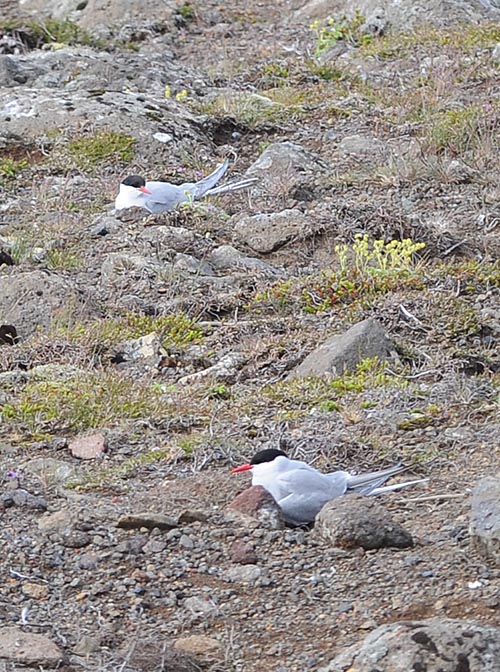
It nidifies in desolate tundras, stony beaches, banks of waterways, barren prairies, sides of hills coasting fjords and various inhabited sites of Iceland or Geenland © Colombo
Thus, they got the certainty of terns ringed in England found three moths after the take off in Australia, others from Greenland found after four months in South Africa and of a group of juveniles ringed in Holland and followed in a fantasy route that took them along the Atlantic up to South Africa, then up to Australia and Tasmania, with a turn southwards up to the Antarctic ice pack and coasting the ices up to the extreme south of the Atlantic Ocean and then back on the road of return up to the birthplace.
The etymology of the genus Sterna, habitually used in the scientific term as well as in many vulgar names, comes from the old Norse “terne” and Swede “tӓrna”.
More appealing is the definition of “paradisaea”, a Latin term coming from the old Greek “paradeisos” but derived in its turn from the primitive Persian “pairi-daeza”, that with this term defined “the land of the Persian Kings’ pleasure”. A reference to describe its gentleness, the refinement, the nimbleness and elegance of this bird flight.
Other popular names are: Arctic Tern in English; Küstenseeschwalbe in German; Charrán ártico in Spanish; Sterne arctique in French; Andorinha-do-mar-árctica in Portuguese; Sterna artica or Sterna codalunga in Italian and a nice Kyokuajisashi in Japanese.
Zoogeography
The Arctic tern nidifies in the Arctic belt of the northern hemisphere, getting down to southernmost latitudes only in England, along the coasts of the Baltic Sea and along the Atlantic coasts of south-eastern Canada.
Practically, it is the Arctic corresponding of the more usual Common tern (Sterna hirundo) very frequent in the temperate zones of the planet and with which it overlaps the areas in the points of contact.
Taking into account the remote position of the nidification sites, those touched by the very long migration and added to the unpredictable wandering on the routes of the whole world, we can affirm that this bird is present, in the different seasons, in all the seas and oceans of our planet. The Arctic tern reaches the nidification sites by late May but also in full June and remains in the territory of reproduction delaying over time the departures depending on the latitudes, up to late September.
However short can be its stay in these places, this tern takes advantage of an exceptional number of hours of light per day that greatly facilitates it in the growth of the offspring. From this month will begin again that untiring wandering southwards that will last up to the next May when the instinct will lead it back to the native locations.
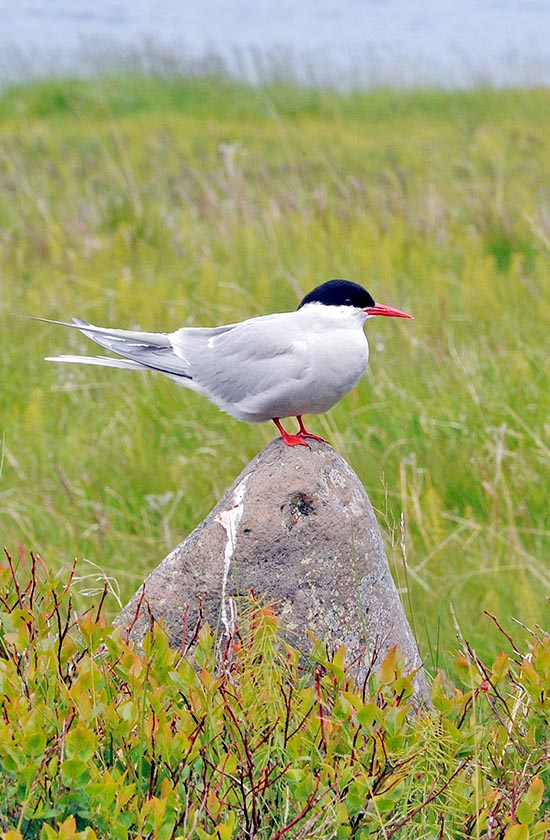
A male on lookout surveys possible predators © Gianfranco Colombo
When on the ground for the nidification it frequents desolate tundras, stony beaches, banks of small banks and of watercourses, barren grasslands, steep sides of hills that border the fjords and, in inhabited places such as Iceland or Greenland, also in the meadows close to farms or shelters for animals.
Morpho-Physiology
The differences distinguishing the Arctic tern from the Common tern (Sterna hirundo), are very few and hard to detect when in flight. Only the experienced eye and many years of specific experience on this species, succeed in giving guarantee of a correct classification of the animal you are observing.
There is a saying among ornithologists, when unable to classify exactly which of the two species they are facing, that identifies facetiously this difficulty. They say sneeringly that it is a “Commic Tern”, a mix between the comic or common stern, thus avoiding any risk of confusion and a possible bad figure.
The Arctic tern is a 40 cm long bird, with a weight of about 100 g and a wingspan of 75 cm, a measure that by itself is sufficient for understanding who it is facilitated in flight.
It has slender sickle-shaped wings, typical of the migratory birds, a shape that favors the aerodynamics and the lift in gliding flight, allowing the exploitation of the slightest breeze without any effort.
In wedding livery, the overall colouration is of a very weak light blue grey, more marked on the wings whilst the chest shows only a trace of the same. In some individuals, this grey shade on the chest is fairly marked.
The very slender body and the rather biforked tail, are, on the contrary, of a candid white colour.
On the head it has a very dark hood that starting from the front and keeping over the line of the eyes, gets down to cover the nape. The bill is blood red, as well as the webbed feet. There is no sexual dimorphism. During the winter the black hood disappears on the frontal part and becomes simply a bilateral spot that starting from the ocular globes merged on the nape. The bill and the feet become blackish.
The most evident differences with the common tern, always very difficult to see and verifiable only if observing at the same time the two species, can be summarized in three points.
In the common tern the bill is of a darker red colour with the tip usually black. The legs are usually longer even if both when on the ground seem to be absent as much as they are short. The chest of the common tern is wholly candid. Unluckily, there is nothing to do when they are in winter livery even if the habitats hardly do overlap.
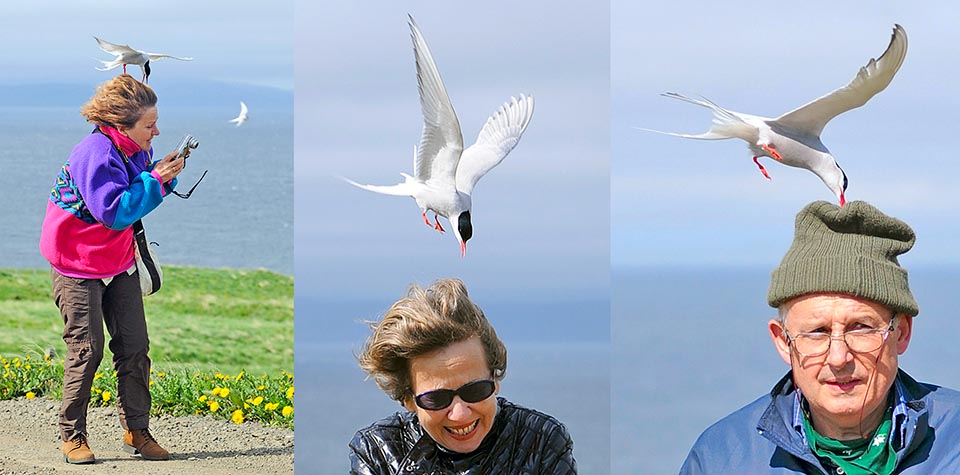
Also man, like all intruders, is attacked with no fear with noisy painful pecks, often bleeding © Gianfranco Colombo
Ethology-Reproductive Biology
The Arctic tern stands among the smallest terns, but is the most reckless and aggressive in defending the territory and the nest. This characteristic makes many other birds to unite to these colonies in order to take advantage of the defence created by this mutual aid. To talk of aggressiveness is an understatement for this bird. All animal aggregations form instinctively a defence force when aggressed by external persecutors but there are limits beyond which no one dares to go in order not to jeopardize its own safety.
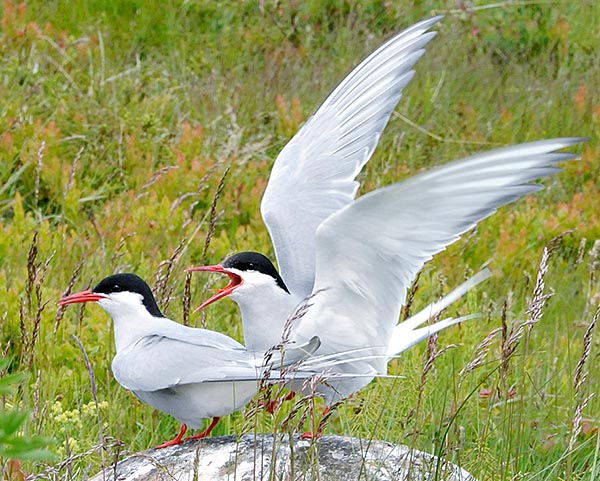
Female courted on the ground. It arrives in Europe in May-June and leaves in September © G. Colombo
In the Arctic tern this limit is well passed and at times is really impressive.
The tern attacks all intruders who endanger the safety of its territory, regardless the size and the aggressiveness of the predator but at times it exceeds without any reason and inexplicably.
They attack sheep and cows, dogs and cats, horses and wild animals as well as birds of prey as well as geese, ducks and seagulls. Absolutely everyone, inexorably, we humans included.
It is sufficient to pass close to their territory even onboard a car that immediately we are attacked from every side by swarms of these swallows, with the risk of seeing them entering through the side windows.
They arrive from every side, flying very fast and almost invisible, carried by the extremely strong gusts of wind, with dizzying nosedives in beaten flight and hit with an absolute precision the head with their pointed bill.
They show with noisy and very painful, often bleeding, pecks their way of welcoming the visitors.
The Arctic tern nourishes of small fishes it catches with great mastery diving from a ten of metres from the surface and immersing even totally. It fishes also touching gently the surface and seizing with precision small floating animals or crustaceans and almost invisible to the human eye. On the nidification sites, it chases also insects catching them on the fly or collects on the shoreline small crabs and other marine mollusks.
The sexual maturity of the Arctic tern is reached after the third year of age even if usually it returns to the native countries every year though not nidifying. The couple is stable and it is thought to be lasting for life. This does not mean that the partners upon their arrival in the nidification territory proceed to the usual courting, aerial of course, which provides flights in parade with the offering of tiny fishes to the female.
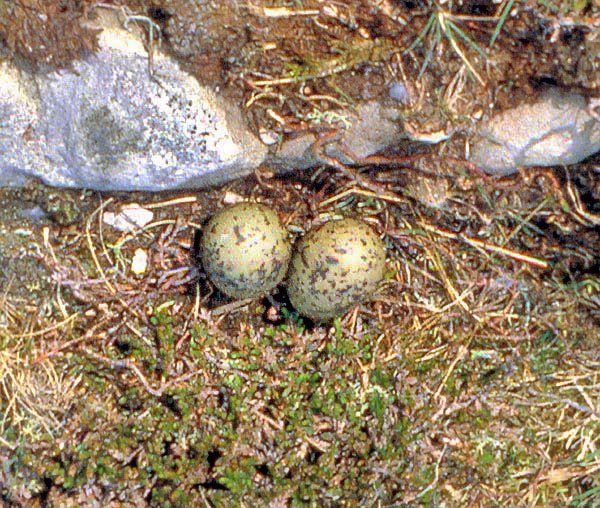
The nest is a simple dip in the ground, with usually 1-2 eggs brooded for a month © Gianfranco Colombo
The Arctic stern is not very prolific seen that it lays only one to two eggs and quite rarely three, considered the adventurous life subject to risks to which it is usually subjected.
The breeding lasts three weeks about and the task is split between the partners but their aggressiveness towards anyone crossing their area very often leads them to get away from the nest even for a few minutes therefore the hatching may take place even after 30 days.
The pullets come to life with a thick and well cryptic down and leave almost immediately the nest for moving at a very short distance, just for reaching some lichen or tuft of grass for camouflaging.
They get off and become independent after three weeks more.
Many are the natural foes, in particular from the sky and include rabbis, skuas, black-backs, but also foxes, weasels, cats and mice.
Even in face of this situation, united to the poor fertility, the species is considered as abundant and consequently is not included among the endangered species.
Synonyms
Sterna macrura Nitzsch, 1820; Sterna arctica Temminck, 1820; Sterna argentata Brehm, 1822; Sterna brachytarsa Graba, 1830; Sterna oceani Brehm, 1831; Sterna senegalensis Swainson, 1837; Sterna pikei Lawrence, 1853; Sterna longipennis Coues, 1872: Sterna portlandica Ridgway, 1874.
→ For general information about the Charadriiformes please click here.
→ To appreciate the biodiversity within the CHARADRIIFORMES please click here.
